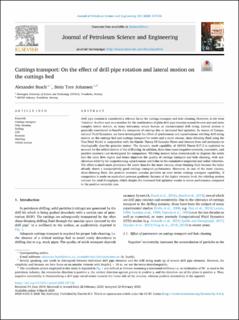| dc.contributor.author | Busch, Alexander | |
| dc.contributor.author | Johansen, Stein Tore | |
| dc.date.accessioned | 2020-09-14T14:12:28Z | |
| dc.date.available | 2020-09-14T14:12:28Z | |
| dc.date.created | 2020-03-11T16:26:26Z | |
| dc.date.issued | 2020 | |
| dc.identifier.issn | 0920-4105 | |
| dc.identifier.uri | https://hdl.handle.net/11250/2677764 | |
| dc.description.abstract | Drill pipe rotation is considered a relevant factor for cuttings transport and hole cleaning. However, in the term “rotation” is often used as a moniker for the combination of plain drill pipe rotation around its own axis and more complex lateral motion, as many laboratory setups feature an unconstrained drill string. Lateral motion is generally considered to benefit the transports of cuttings due to increased bed agitation. By means of Compu-tational Fluid Dynamics, we have investigated the effect of synchronous and asynchronous whirling drill string motion on the cuttings bed and cuttings transport for water and a more viscous, shear-thinning fluid using the Two Fluid Model in conjunction with the Kinetic Theory Of Granular Flows and closures from soil mechanics to rheologically describe granular matter. The dynamic mesh capability of ANSYS Fluent R17.2 is exploited to account for the orbital motion of the drill string. In addition, three base cases (negative eccentric, concentric, and positive eccentric) are investigated for comparison. Whirling motion helps tremendously to disperse the solids into the main flow region and hence improves the quality of cuttings transport and hole cleaning, with syn-chronous whirl by far outperforming asynchronous whirl due to the cumulative tangential and radial velocities. The effect is much more prominent for water than for the more viscous, shear-thinning fluid because the latter already shows a comparatively good cuttings transport performance. Moreover, in case of the more viscous, shear-thinning fluid, the positive eccentric annulus provides an even better cuttings transport capability, if comparison is made on equivalent pressure gradients. Because of the higher viscosity level, the whirling motion reduces the axial throughput, which despite the increased bed agitation results in worse performance compared to the positive eccentric case. | en_US |
| dc.language.iso | eng | en_US |
| dc.publisher | Elsevier | en_US |
| dc.rights | Navngivelse 4.0 Internasjonal | * |
| dc.rights.uri | http://creativecommons.org/licenses/by/4.0/deed.no | * |
| dc.title | Cuttings transport: On the effect of drill pipe rotation and lateral motion on the cuttings bed | en_US |
| dc.type | Peer reviewed | en_US |
| dc.type | Journal article | en_US |
| dc.description.version | publishedVersion | en_US |
| dc.source.volume | 191 | en_US |
| dc.source.journal | Journal of Petroleum Science and Engineering | en_US |
| dc.identifier.doi | 10.1016/j.petrol.2020.107136 | |
| dc.identifier.cristin | 1801193 | |
| dc.relation.project | Norges forskningsråd: 228391 | en_US |
| dc.description.localcode | © 2020 The Author(s). Published by Elsevier B.V. This is an open access article under the CC BY license (http://creativecommons.org/licenses/by/4.0/). | en_US |
| cristin.ispublished | true | |
| cristin.fulltext | original | |
| cristin.qualitycode | 2 | |

